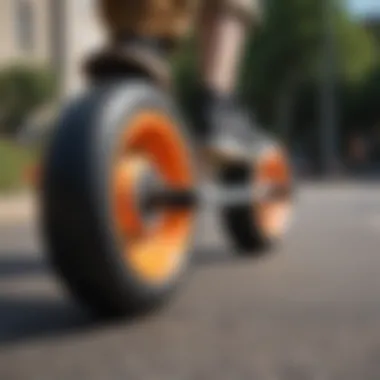Choosing the Perfect Longboard: Expert Guide


Intro
Longboarding is not just a simple recreational activity; it is a way to express freedom and an adrenaline-packed experience for many enthusiasts. Selecting the right longboard is critical to enjoying this thrilling sport. Understanding your skill level, preferred riding style, and the terrain can significantly influence your choice. This guide aims to distill complex factors into actionable insights, allowing both beginners and experienced riders to navigate their options effectively.
As we delve into the nuances of longboarding, we will discuss the various types of longboards available, focusing on deck materials, wheel specifications, and compatibility with other gear. It is essential to grasp these components to ensure that the longboard complements your unique riding needs and goals.
Equipment and Gear
In the world of longboarding, safety and performance go hand in hand. Choosing the right gear is crucial for a safe and enjoyable ride. This section will explore the essential equipment that goes beyond just the board itself.
Overview of Essential Gear
- Helmets: A crucial element of safety gear. Helmets must be fitted correctly to provide maximum protection. Look for models that meet safety standards like CPSC or ASTM.
- Pads: Knee and elbow pads offer added cushioning against falls. They come in varying thicknesses and materials, providing options for comfort and flexibility.
- Gloves: Riding gloves serve a dual purpose: grip and protection when you brake or fall.
- Shoes: Footwear can greatly affect your riding experience. It’s best to choose shoes with a flat sole for better board control.
Detailed Descriptions of Top Brands
Many brands specialize in longboarding gear that meets the needs of various riders:
- Sector 9: Known for its high-quality boards and durability.
- Triple Eight: Offers excellent safety equipment with comfortable fit.
- Santa Cruz: Produces boards that not only perform well but also feature unique designs.
Quality gear serves as an investment for safety and performance, and it is advisable to consider personal preferences and budget.
Tips on Maintenance, Upgrades, and New Advancements
Regular maintenance can extend the lifespan of your gear. Here are a few tips:
- Check bearings, wheels, and trucks for any signs of wear.
- Clean the wheels and bearings periodically to avoid dirt buildup.
- Upgrade uniquely based on your style. For example, try different wheel durometers for varying surfaces.
Stay informed about new products and gear innovations, as they can enhance your riding experience. Many companies now focus on eco-friendly materials too, catering to environmentally conscious consumers.
"The right gear can make all the difference in enjoying longboarding without unnecessary injuries."
As you explore the world of longboarding, ensure that your equipment communicates with your riding style for optimal performance.
Understanding Longboarding
Longboarding represents more than just a mode of transport; it embodies a way of life for many enthusiasts. Comprehending this sport is crucial for anyone considering their own longboard. The insights gained can assist in making informed decisions when it comes to selecting the right board. It involves recognizing the various styles, shapes, and types available, as well as how these elements align with individual preferences and skill levels.
Understanding longboarding can enhance the overall experience. Selecting an appropriate longboard can significantly affect performance, comfort, and safety. When one knows the basic components of longboarding, they become more equipped to navigate their choices.
What is Longboarding?
Longboarding shares common roots with skateboarding but sets itself apart through design and purpose. Unlike the shorter skateboards, longboards typically span 33 inches to 59 inches in length. This extended length offers better stability and greater ease of use, especially for novice riders.
Longboards can be utilized for various purposes, including cruising, downhill racing, and freestyle tricks. Each type of longboard serves different riding styles and environments. The longer deck can also provide more room for foot placement, which adds comfort during long rides.
History of Longboarding
The origins of longboarding can be traced back to the 1950s in California. Surfers aimed to replicate their surfing experience on land, leading to the creation of longer and wider boards. This early form of longboarding, often called "sidewalk surfing," laid the groundwork for the sport as we recognize it today.
Throughout the decades, longboarding has undergone substantial evolution. In the 1970s, advancements in materials and design, such as the introduction of polyurethane wheels, improved durability and performance significantly.
In recent years, the rise of technology has further diversified longboarding culture, expanding its reach worldwide. Longboarding communities now thrive on platforms such as Reddit and various social media, where enthusiasts share tips, tricks, and experiences.
Understanding this history provides valuable context about the sport. It emphasizes how culture and innovation shaped the longboarding we know today, highlighting the community aspect of the sport.
"Longboarding isn’t confined to speed or tricks; it’s also about the journey and genuine connection with others."
In summary, grasping what longboarding is and its historical backdrop equips riders with essential knowledge to choose the right gear according to their needs.
Types of Longboards
Understanding the types of longboards available is essential for anyone looking to make an informed choice. Each type serves a specific purpose, catering to different riding styles and preferences. By knowing what each type offers, riders can select a longboard that aligns with their needs and enhances their experience.
Cruiser Longboards


Cruiser longboards are designed for comfort and ease of use. They typically feature a wider deck and softer wheels, which enable smooth rides over various surfaces. These longboards excel in urban environments, allowing riders to navigate through city streets comfortably.
Benefits of Cruiser Longboards:
- Maneuverability: Ideal for navigating tight spaces with agility.
- Comfort: Softer wheels absorb shocks, making it suitable for beginners.
- Versatility: Great for short commutes and leisurely rides.
When considering a cruiser longboard, ensure that the deck size matches your foot size for the best balance and control.
Freeride Longboards
Freeride longboards provide versatility and are perfect for performing tricks and slides. They often feature symmetrical designs, allowing riders to ride in either direction. This type tends to have a stiffer deck, facilitating better control at high speeds.
Key Characteristics of Freeride Longboards:
- Stability: Stiffer construction leads to better balance during tricks.
- Sliding Capability: Designed specifically for performing slides, beneficial for skilled riders.
- Performance Optimization: Ideal for downhill enthusiasts who enjoy speed.
Freeride boards are generally not the best choice for beginners due to their advanced nature, but if you have some experience, this type can elevate your riding skills.
Downhill Longboards
Downhill longboards are made for speed and stability while going downhill. They are characterized by their long wheelbase and low center of gravity, which enhances stability at high speeds. Riders often seek downhill boards for racing or high-speed cruising.
Attributes of Downhill Longboards:
- Aerodynamics: Designed to minimize air resistance, improving speed.
- Control: Equipped with high-quality wheels and trucks for maximum grip.
- Safety Features: Often come with added stability measures to prevent wobbling.
Choosing a downhill longboard requires careful consideration of wheel hardness and size, as these factors significantly influence performance and safety when clocking high speeds.
Freestyle Longboards
Freestyle longboards are crafted for creativity and trick performance. They typically have a symmetrical shape and a flexy deck, allowing for various stunts and maneuvers. Riders enjoy the flexibility of these boards for innovative skating styles.
Features of Freestyle Longboards:
- Flexibility: The construction allows for performing a range of tricks.
- Symmetrical Design: This feature enables riding in either direction easily.
- User-Friendly: Suitable for riders with a good grasp of balance and coordination.
This type of longboard is great for artistic riders who want to express themselves through movements and stunts, enhancing their longboarding experience.
Remember, the right longboard type can greatly improve your enjoyment and performance while riding. Take the time to consider your riding preferences before making a decision.
Key Components of a Longboard
Understanding the key components of a longboard is fundamental as it influences not only the performance but also the experience of riding. Each component plays a critical role in determining how the longboard functions under various conditions and for different riding styles. Knowledge of these components empowers riders to make informed choices that cater to their specific needs.
Deck Types and Shapes
The deck of a longboard is its main platform, and it comes in various shapes and sizes, each with distinct characteristics. Choosing the right deck is crucial because it affects stability, maneuverability, and overall ride comfort. Here are some popular types:
Completely Flat
Completely flat decks are known for their simple and clean designs. They provide a stable surface that is ideal for beginner riders. The key characteristic of this type of deck is its uniformity in height, which reduces the chance of wobbling when cruising. This stability makes it a favored choice for those who prioritize comfort over tricks. However, these decks may lack advanced maneuverability required for aggressive riding or tricks.
Drop-through decks
The drop-through design features the deck sitting lower than the wheels. This setup lowers the center of gravity, which enhances stability and provides greater control when riding at high speeds. The drop-through characteristic makes it a beneficial option for downhill riding. Nonetheless, one must consider that the setup can result in a slightly reduced strength at the connection points between the deck and trucks.
Kicktails
Kicktails are raised sections at the back and sometimes the front of the longboard. They allow riders to perform tricks and maneuvers like popping off the ground for ollies or immediate turns. The unique feature of kicktails is their versatility, giving freedom to perform tricks while also providing a reliable way to push off. However, adding kicktails might result in a slightly heavier board, which might not be suitable for all riders.
Trucks: Selection and Importance
Trucks are an essential component that connects the wheels to the deck and dictate how a board turns and behaves. Choosing the right trucks is critical because their width, height, and material influence the stability and responsiveness of the longboard. For instance, wider trucks provide additional stability, great for downhill riding, while narrower trucks allow for sharper turns. Regular maintenance ensures that trucks remain in good condition, as worn-out components could lead to a compromised riding experience.
Choosing the Right Wheels


The performance of a longboard heavily relies on the wheels. Understanding wheel specifications is essential as they affect speed, grip, and comfort while riding. Consider the following aspects:
Hardness and Durometer
Hardness is measured in durometer, which is a scale indicating how soft or hard the wheel is. Softer wheels (around 78A-87A) provide more grip and are excellent for rough terrains, offering comfort during rides. In contrast, harder wheels (88A-101A) are faster and better suited for smooth surfaces but can deliver a rougher ride on uneven roads. Choosing the right hardness directly corresponds to your riding environment and style.
Diameter
The diameter of the wheels affects acceleration, speed, and stability. Larger wheels (around 70-80mm) roll over obstacles more smoothly and maintain speed efficiently. Smaller wheels (below 60mm) can provide better grip and responsiveness, often preferred in technical riding. Selecting the right diameter is key to achieving the desired balance between speed and control.
Material Composition
Wheel material impacts durability, grip, and performance. Most wheels are made from urethane, offering a good mix of grip and lasting wear. The concern lies in the density of the urethane used; higher density indicates a harder wheel that is less grippy but faster. Conversely, softer materials can grip better but wear faster. Knowing the composition leads to informed decisions about longevity and suitability for riding surfaces.
"The choice of components significantly influences riding experience. Ensure all parts align with your riding style and terrain preference."
In summary, the key components of a longboard encompass deck types, trucks, and wheels. Each of these aspects should be considered carefully to align with your specific needs and style. An informed choice guarantees a more enjoyable and safe longboarding experience.
Assessing Your Riding Style
Understanding your riding style is critical when selecting the right longboard. Each rider has unique preferences and skills, which influence the type of board that will best suit them. The need to align your longboard choice with your style ensures a better riding experience, greater control, and enhanced enjoyment. Far beyond mere aesthetics, the appropriate board can profoundly affect how you glide, turn, and perform tricks.
Identifying Your Skill Level
Beginner
For beginners, the focus typically lies on safety and comfort. A key characteristic of beginner riders is the lack of experience with speed and maneuvering, making stability vital. The best longboards for beginners often feature wider decks and softer wheels, aiding in balance and preventing slips. This makes them a beneficial choice as they promote confidence and skill development in a controlled manner. However, beginners may find these boards less responsive to rapid movements, which can be a disadvantage as they advance.
Intermediate
Intermediate riders usually wish to expand their skills and experience. The intermediate skill level allows for a greater understanding of balance, speed control, and turning. Longboards designed for this group often have a mix of flexibility for tricks and stability for downhill rides. Using an intermediate board enables riders to experiment with various techniques. The unique feature of these boards often includes a balanced construction that caters to diverse riding styles. Nevertheless, some models may lack the precision needed for high-speed downhill racing.
Advanced
Advanced riders require boards that meet high performance standards. The key characteristic of advanced board choices is the optimization for speed, agility, and control during tricks or downhill runs. These boards often incorporate advanced materials to reduce weight and increase durability. The unique feature of an advanced longboard typically lies in its responsiveness, allowing experienced riders to execute complex maneuvers effectively. However, these boards can be less forgiving to mistakes, posing potential risks for those who are still refining their skills.
Evaluating Terrain Preferences
Urban environments
When riding in urban settings, riders face unique challenges like navigating uneven pavements, tight turns, and obstacles. A major characteristic of urban environments is their variety; the mix of surfaces requires longboards that can adapt to different conditions. Boards suitable for this environment often feature a smaller size for agility and maneuverability. They are often lightweight, making it easier to transport. Nevertheless, urban riding can sometimes lead to quicker wear on wheels due to harsher surfaces, a disadvantage to consider.
Hills and slopes
Riding downhill or on hilly terrains is both thrilling and challenging. The key characteristic of hills and slopes is the need for speed and maximum control. Longboards for this type often have a lower center of gravity and robust trucks to assist with stability. This allows for smooth rides down steep gradients. A unique feature of these boards can be specialized wheels designed for high speed and grip. However, beginners might find downhill riding intimidating due to the potential for accidents, making it crucial to have experience before attempting.
Smooth pathways
Smooth pathways provide an ideal setting for cruising and enjoying your rides. The key characteristic of smooth pathways is their consistency, allowing for faster speeds and easier maneuvering. Longboards suited for this terrain are often longer and have larger wheels. This allows for a smooth and stable ride, emphasizing comfort and enjoyment for all riders. The unique feature of boards for smooth surfaces typically includes lightweight materials for extended rides without fatigue. However, smooth pathways may not provide the thrill some riders seek, which could make it a less exciting option for the adrenaline enthusiast.
Assessing your riding style is an essential step in selecting a longboard. It allows you to find a board that seamlessly aligns with your skills and riding preferences, enhancing both safety and enjoyment.
Factors Influencing Longboard Choice
Choosing the right longboard involves a myriad of factors that go beyond just the aesthetics. Understanding these elements can greatly enhance your riding experience. In this section, we break down the key influences on longboard selection, addressing pocket and personal preferences as much as technical specifications.
Budget Considerations
Budget plays an essential role in any purchasing decision. Different brands and models vary significantly in cost, thus understanding what you can afford is crucial. Longboards can range from inexpensive entry-level options to high-end models favored by professional riders. When setting your budget, consider that spending more can often lead to better quality and performance.
However, a higher price does not always guarantee a suitable longboard for your style. For instance, a beautiful deck may look appealing but may not offer the grip needed for downhill rides. Explore various choices and balance between performance requirements and what you can spend.
Factors to consider:
- Entry-level boards: Suitable for beginners, typically low in cost.
- Mid-range models: Offer a decent balance of quality and price.
- Premium boards: Feature advanced technology and materials but might be overkill for a casual rider.


Durability and Maintenance
Durability is another core aspect to weigh when selecting a longboard. Longboards endure various types of stresses depending on how and where you ride them. Consider the materials used in both the deck and wheels. For instance, a bamboo deck offers flexibility, while maple provides strength. Knowing this can guide your decision based on terrain preferences.
Maintenance is equally important. Some longboards require more attention than others, especially if they feature components prone to wear and tear. Ensure you research not just the initial purchase price but also any potential ongoing costs.
Key points:
- Material impact: Hardwoods may last longer but add weight.
- Maintenance frequency: A properly maintained board can greatly enhance longevity.
Aesthetic Preferences
Aesthetics might seem secondary to performance, but they undeniably influence your choice. A longboard that aligns with your personal style can enhance your connection to the sport. There are countless designs available, from sleek contemporary shapes to colorful graphics. In addition, some riders feel more confident on boards that reflect their individuality.
While selecting based on looks, ensure you do not overshadow functional needs. Therefore, finding a balance is crucial. Consider how the appearance of the longboard complements its performance.
Consider your preferences:
- Deck graphics: Many brands offer unique designs.
- Color schemes: Choose colors that resonate with you.
Choosing a longboard is like finding a partner; it's about more than just looks—performance and compatibility matter.
Ultimately, when evaluating the factors influencing longboard choice, think critically about how each aspect aligns with your specific riding style and needs. This way, your decision-making process becomes a more informed and fulfilling journey.
Potential Brands and Models
Selecting the right longboard is greatly influenced by the brands and models available in the market. Each brand brings its own unique features, riding characteristics, and construction quality. For avid longboard enthusiasts, the choice of brand can denote reliability and craftsmanship. Established brands have constructed their reputations through consistent performance and innovative design. It is crucial to recognize the differences among these brands as they can significantly impact your longboarding experience.
Top Longboard Brands
When considering top brands in the longboarding industry, several names stand out due to their quality and design philosophy. Here are some notable brands:
- Santa Cruz: Known for its durable construction and unique art designs on decks, Santa Cruz has been a favored choice for longboarders seeking a blend of style and performance.
- Sector 9: This brand specializes in a wide variety of longboarding styles, ensuring that there is something for everyone. Their boards are often praised for their stability and ease of use.
- Land Yachtz: Offering both performance and aesthetics, Land Yachtz is recognized for its innovative shapes and designs. They provide boards tailored for downhill, freestyle, and cruising.
- Arbor: Arbor emphasizes sustainability in their manufacturing process. Their boards often reflect a blend of eco-friendliness with high-performance characteristics, making them appealing for socially conscious riders.
Each of these brands has a variety of models suited for different riding styles and preferences, offering numerous options for both new and experienced riders.
Model Comparisons
Comparing models across various brands allows riders to make informed choices based on their specific needs. When analyzing different models, consider the following aspects:
- Deck Shape and Length: Some boards are designed for tricks; others are optimized for speed. For example, the Sector 9 Lookout is designed for cruising, while the Land Yachtz Dinghy is more suited for tricks and technical riding.
- Wheel Size and Composition: Larger wheels can provide a smoother ride over rough terrain, while smaller wheels are often better for tricks and stunts. Compare the wheel hardness too, since softer wheels grip better but wear out quicker.
- Price Range: Longboards can vary greatly in price. For instance, Arbor's entry-level boards might be more affordable compared to higher-end models from Santa Cruz that offer premium features.
"Choosing a model that aligns with your riding style is essential for enhancing your longboarding experience."
Assessing these elements ensures that you select a longboard that suits your preferences, enhancing both performance and enjoyment. In summary, understanding the available brands and their specific models greatly influences your decision. Do extensive research, and consider personal needs as well as brand reputation when making your selection.
Finalizing Your Decision
Choosing the right longboard is essential as it influences your overall riding experience. After researching and understanding your options, finalizing your decision involves several factors to consider. These factors can help ensure that you select the perfect longboard to meet your individual needs and style.
First, understanding where to purchase your longboard can significantly impact your decision-making process. Different retailers may offer various models, prices, and customer services. It is wise to compare both online and local shops to find the best option. Local skate shops often provide knowledgeable staff who can offer valuable insights and recommendations. Online retailers may have wider selections and potentially better prices, but the ability to physically test a longboard is often absent.
Also, consider the warranty and return policies provided by sellers. A good warranty may indicate a manufacturer’s confidence in their product quality. A flexible return policy is crucial, especially for beginners, as it allows you to test the longboard and exchange it if it does not meet your expectations.
Moreover, make sure to assess compatibility with existing gear. Not all longboards come equipped with the same components, such as trucks and wheels, which can affect performance. Ensure that the longboard complements any gear you already own. This preparation will save you potential additional expenses and enhance your riding capability.
In summary, effectively finalizing your decision requires careful consideration of retailer options, warranty and return policies, and gear compatibility. Doing this will lead to a satisfying longboarding experience.
Where to Buy Your Longboard
When it comes to purchasing a longboard, options are plentiful. Assess both physical and online stores. Local skate shops offer the advantage of personalized advice. You also get the chance to view and test longboards in person, which can help gauge how a board feels under your feet.
On the other hand, online platforms such as Amazon or specialized websites provide extensive variety and often more competitive prices. However, buyers cannot always test before buying.
Here are some popular choices for where to buy:
- Local skate shops: Great for hands-on experience and expert advice.
- Online retailers: Better options, more pricing flexibility.
- Sporting goods stores: Often carry beginner-friendly models.
- Marketplaces like Craigslist or Facebook Marketplace: Potential for used boards and deals but requires caution.
Tips for Testing Your Longboard
Once you have narrowed down your choices, testing the longboard becomes crucial. Here are some suggestions for effectively testing:
- Physical Feel: Ride the board to see how it feels. Pay attention to stability, weight, and turning radius.
- Terrain Testing: Attempt to ride the longboard on various surfaces like paved roads, hills, and uneven terrain. This helps assess its performance under real conditions.
- Check Comfort: Make sure that your stance feels natural. Fatigue can ruin longboarding experiences.
- Evaluate Responsiveness: Make sharp turns and practice stopping to see how well the board responds to your actions.
- Ask for Opinions: If possible, get feedback from experienced riders or knowledgeable shop staff for insights on your experience.















